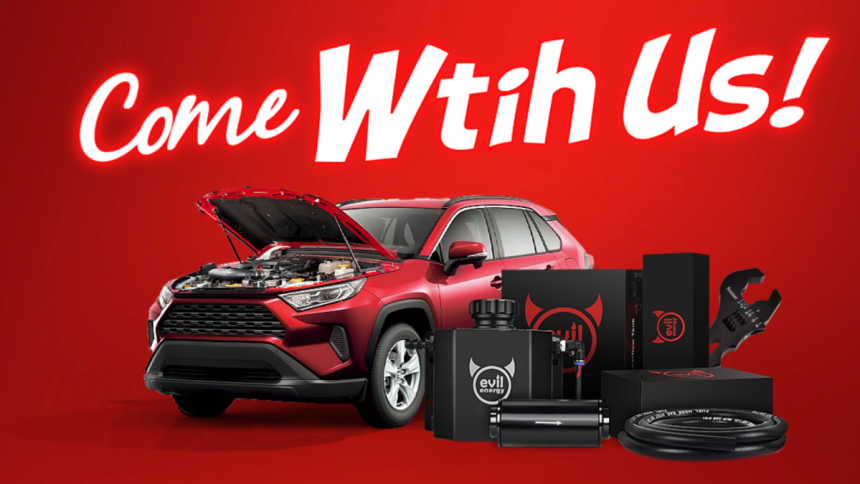In the automotive performance and reliability world, aftermarket upgrades play a crucial role in enhancing the performance, durability, and overall driving experience of vehicles. Two essential components that are often upgraded by enthusiasts and mechanics alike are fuel lines and transmission coolers. This comprehensive guide delves into the intricacies of Evil Energy fuel lines and transmission coolers, exploring their features, benefits, installation processes, and maintenance tips to help you make informed decisions when upgrading your vehicle.
Understanding Evil Energy Fuel Lines
What are Evil Energy Fuel Lines?
Evil Energy fuel lines are high-performance aftermarket components that replace factory fuel lines with superior materials, construction, and performance characteristics. These fuel lines are engineered to withstand higher pressures, resist corrosion and abrasion, and provide optimal fuel flow to support increased horsepower and torque outputs.
Features and Benefits
- High-Quality Materials: Evil Energy fuel lines are constructed from premium materials such as stainless steel, aluminum, or braided nylon, ensuring durability and longevity in demanding automotive applications.
- Enhanced Performance: Evil Energy fuel lines can improve engine performance, throttle response, and fuel efficiency by optimizing fuel flow and reducing restrictions.
- Corrosion Resistance: The materials used in Evil Energy fuel lines are resistant to corrosion, rust, and degradation, even in harsh environments or when exposed to fuels with ethanol content.
- Flexibility and Versatility: Evil Energy fuel lines are available in various configurations, lengths, and diameters to accommodate different vehicle setups and fuel system requirements.
Types of Evil Energy Fuel Lines
- Braided Stainless Steel: Braided stainless steel fuel lines offer superior strength, durability, and abrasion resistance, making them ideal for high-performance and racing applications.
- Aluminum: Aluminum fuel lines are lightweight and corrosion-resistant, making them suitable for street and track use.
- Nylon Braided: Nylon braided fuel lines provide flexibility, ease of installation, and resistance to abrasion and heat, making them a popular choice for budget-conscious enthusiasts.
Installation Process for Evil Energy Fuel Lines
- Preparation: Gather all necessary tools and components. Ensure the vehicle is parked on a level surface and the engine is excellent.
- Disconnect Battery: To prevent electrical hazards, disconnect the vehicle’s battery.
- Remove Factory Fuel Lines: Unbolt and remove the factory fuel lines, starting from the fuel tank and working toward the engine.
- Install New Fuel Lines: Install the Evil Energy fuel lines, ensuring proper routing and secure connections at both ends. Use the appropriate fittings and adapters as needed.
- Pressure Test: Once installed, pressure test the fuel system to check for leaks and ensure proper operation.
- Final Inspection: Start the engine and check for fuel leaks or abnormal operation. Tighten any loose connections as needed.
Maintenance Tips for Evil Energy Fuel Lines
- Regular Inspections: Periodically inspect the fuel lines for signs of damage, corrosion, or leaks. Pay close attention to fittings, connections, and areas where the lines may contact other components.
- Cleanliness: Keep the fuel lines clean and free from dirt, debris, and contaminants to prevent blockages and maintain optimal fuel flow.
- Avoid Abrasion: Ensure the fuel lines are properly routed and secured to prevent rubbing against sharp edges or abrasive surfaces, which can lead to wear and potential failure.
Understanding Transmission Coolers
What are Transmission Coolers?
Transmission coolers are auxiliary heat exchangers designed to dissipate excess heat from automatic transmissions during operation. By removing heat from the transmission fluid, transmission coolers help maintain optimal operating temperatures, prolong the life of the transmission, and prevent overheating-related issues such as fluid breakdown and component failure.
Features and Benefits
- Improved Cooling Capacity: Transmission coolers provide additional cooling capacity beyond what the vehicle’s stock cooling system offers, allowing for more efficient heat dissipation and temperature regulation.
- Extended Transmission Life: Transmission coolers can extend the life of the transmission and its internal components by reducing operating temperatures and preventing fluid breakdown, reducing the risk of costly repairs or replacements.
- Enhanced Performance: Cooler transmission fluid can improve shift quality, reduce transmission slippage, and maintain consistent performance, especially under heavy loads or during towing.
- Easy Installation: Many transmission coolers are designed for easy installation and can be mounted in various locations, including in front of the radiator, behind the grille, or in line with the vehicle’s existing cooling system.
Types of Transmission Coolers
- Tube-and-Fin Coolers: Tube-and-fin transmission coolers consist of metal tubes connected to aluminum fins. Transmission fluid flows through the tubes, while air passing over the fins dissipates heat from the fluid.
- Plate-and-Fin Coolers: Plate-and-fin transmission coolers feature a stacked plate design, with transmission fluid flowing through channels between the plates. This design offers efficient heat transfer and compact size, making it suitable for vehicles with limited space.
- Stacked-Plate Coolers: Stacked-plate transmission coolers are similar to plate-and-fin coolers but feature multiple layers of plates for increased cooling capacity and efficiency.
Installation Process for Transmission Coolers
- Select Location: Determine the optimal location for the transmission cooler, considering airflow, accessibility, and clearance from other components.
- Mount Cooler: Securely mount the transmission cooler using brackets or mounting hardware provided with the kit. Ensure the cooler is positioned securely and does not interfere with other components or airflow.
- Install Fluid Lines: Use fittings, adapters, and hoses to connect the transmission more efficiently to the vehicle’s fluid lines. Ensure all connections are tight and leak-free.
- Pressure Test: Once installed, pressure test the transmission cooler and fluid lines to check for leaks and ensure proper operation.
- Final Inspection: Start the engine and check for transmission fluid leaks or abnormal operation. Tighten any loose connections as needed.
Maintenance Tips for Transmission Coolers
- Regular Inspections: Periodically inspect the transmission cooler for signs of damage, corrosion, or leaks. Pay close attention to fittings, connections, and any areas where the cooler may contact other components.
- Cleanliness: To maintain optimal heat transfer and cooling efficiency, keep the transmission cooler clean and free from dirt, debris, and contaminants.
- Fluid Checks: Monitor transmission fluid levels and condition regularly, as low fluid levels or degraded fluid can affect transmission cooling performance and reliability.
Conclusion
Evil Energy fuel lines and transmission coolers are essential aftermarket upgrades that allow automotive enthusiasts and mechanics to enhance performance, reliability, and durability in their vehicles. Whether you’re looking to optimize fuel delivery, prevent transmission overheating, or improve the overall driving experience, these components provide practical solutions backed by quality craftsmanship and engineering. With proper installation, maintenance, and attention to detail, Evil Energy fuel lines and transmission coolers can deliver lasting performance and peace of mind, allowing you to enjoy your vehicle to its fullest potential on the road or track.
Lynn Martelli is an editor at Readability. She received her MFA in Creative Writing from Antioch University and has worked as an editor for over 10 years. Lynn has edited a wide variety of books, including fiction, non-fiction, memoirs, and more. In her free time, Lynn enjoys reading, writing, and spending time with her family and friends.















